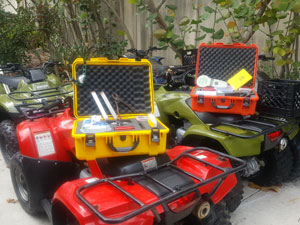Grant: 16-040R
Project Title: Leatherback Sea Turtle Research in Southeast Florida
Project Manager: Kelly Martin
Organization: Florida Leatherbacks Inc. (Non-Profit Organization)
Grant Amount: $12,405.00
Completion Date: 2018-04-09
Summary: Biologists with Florida Leatherbacks Inc. (FLI) have been studying leatherbacks in south Florida for over fifteen years. A mark-recapture program initiated in Palm Beach County in 2001 has identified more than 600 individuals and data collected have been used to define survival rate, remigration interval, population size, clutch frequency, genetic structure, post-nesting movement and many important biological parameters. Beginning in 2014, FLI biologists expanded the study to include Martin County beaches which have shown a recent increase in leatherback density. The study utilizes flipper tags, PIT tags, skin biopsies, measurements, and GPS technology to document and track nesting females. These results have resulted in numerous publications and the study has provided valuable data to local, state and federal management agencies responsible for this important population. Long-term population studies are often the only way to answer many questions about life history, reproductive biology, and habitat use, particularly for long-lived and wide-ranging animals. It is important to continue to use individual identification over a multi-decadal time frame to better understand this population and the potential impacts of anthropogenic forces on its survival. In 2016, FLI will survey 26 miles of densely nested beaches in both Palm Beach and Martin Counties to continue this crucial study. Results: Leatherback research surveys were conducted from March 20 – June 30, 2016 along 13 km of beach extending from the Palm Beach – Martin County line to the St. Lucie Inlet. Funds provided from the Sea Turtle Grants Program provided necessary field equipment including PIT tags, scanners, flipper tags, field books, headlamps, etc. Over 1,200 volunteer hours were used to conduct nightly surveys. Also with grant funds, an additional ATV was purchased on May 25, 2016 and allowed FLI to conduct the first routine surveys of 13 km of Hutchinson Island extending from the House of Refuge to the Martin – St. Lucie County line. During the 2016 season, leatherbacks were encountered a total of 211 times. There were 84 individuals identified with encounter counts ranging from one to eight with each individual. 28 of those individuals were new, untagged females. An additional 7 turtles were new turtles from the 2016 season but were tagged previously in the season by other research groups. 49 turtles were found to have tags applied in previous nesting seasons. Of the 49 recaptures, original tagging dates ranged from 2001 – 2014. In summary, funds from the Sea Turtle Grants Program allowed us to greatly expand upon our existing research and purchase essential field and tagging equipment. The last few years of leatherback research in Florida have highlighted the wide nesting range and large discrepancies in individual nesting behavior. Long-term tagging programs are essential to continue to better understand this population and even more important is the ability to expand to cover a larger portion of the nesting range.
Results: Leatherback research surveys were conducted from March 20 – June 30, 2016 along 13 km of beach extending from the Palm Beach – Martin County line to the St. Lucie Inlet. Funds provided from the Sea Turtle Grants Program provided necessary field equipment including PIT tags, scanners, flipper tags, field books, headlamps, etc. Over 1,200 volunteer hours were used to conduct nightly surveys. Also with grant funds, an additional ATV was purchased on May 25, 2016 and allowed FLI to conduct the first routine surveys of 13 km of Hutchinson Island extending from the House of Refuge to the Martin – St. Lucie County line. During the 2016 season, leatherbacks were encountered a total of 211 times. There were 84 individuals identified with encounter counts ranging from one to eight with each individual. 28 of those individuals were new, untagged females. An additional 7 turtles were new turtles from the 2016 season but were tagged previously in the season by other research groups. 49 turtles were found to have tags applied in previous nesting seasons. Of the 49 recaptures, original tagging dates ranged from 2001 – 2014. In summary, funds from the Sea Turtle Grants Program allowed us to greatly expand upon our existing research and purchase essential field and tagging equipment. The last few years of leatherback research in Florida have highlighted the wide nesting range and large discrepancies in individual nesting behavior. Long-term tagging programs are essential to continue to better understand this population and even more important is the ability to expand to cover a larger portion of the nesting range.